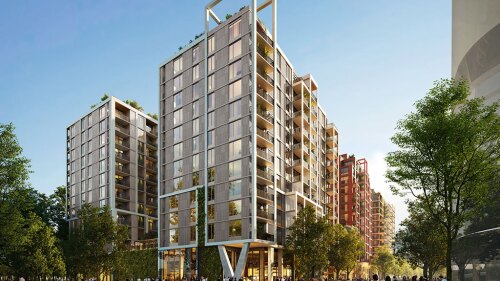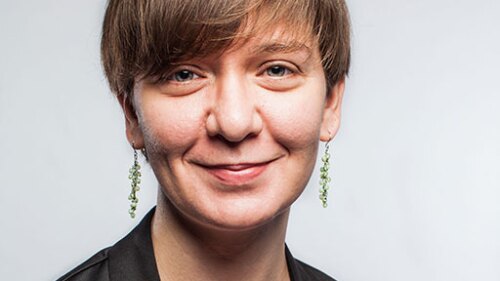Creative uses of transportation infrastructure during the coronavirus pandemic—such as closing streets and using parking lots to accommodate outdoor food markets, dining, and children’s play areas—have helped provide spaces to gather in safer and socially distant ways while supporting local businesses, according to participants in a recent webinar hosted by ULI’s Building Healthy Places Initiative.

Starting at top left in clockwise order: Destiny Thomas, founder and chief executive officer of Thrivance Group; moderator Kim Lucas, assistant director of transportation for the city of Pittsburgh; Warren Logan, policy director of mobility and interagency relations for the city of Oakland, California; and Tony Garcia, principal with Street Plans Collaborative, speaking on a ULI webinar.
The presentation featured Tony Garcia, principal with Street Plans Collaborative, a transportation consulting firm based in Miami; Warren Logan, policy director of mobility and interagency relations for the city of Oakland, California; and Destiny Thomas, founder and chief executive officer of Thrivance Group, a consulting group in Los Angeles that applies culturally restorative concepts to improve underserved communities. The webinar was moderated by Kim Lucas, assistant director of transportation for the city of Pittsburgh.
The webinar is available on-demand along with others in the series in ULI Knowledge Finder.
City of Pittsburgh, Pennsylvania
Lucas began the webinar with an overview of efforts by the Pittsburgh Department of Mobility and Infrastructure (DOMI) to use public space, including streets and sidewalks, to better support people and businesses throughout the pandemic. DOMI’s goals center around safety, affordability, access to fresh food, making short trips doable without an auto, and ensuring that streets reflect the values of the city.
Adapting public spaces to accommodate new uses necessitated by the virus has been DOMI’s main focus because public space “is the primary tool in our toolkit as the managers of public space for the city. We had to figure out ways to modify how it had previously operated in ways that were safe, quick, affordable, and done equitably,” Lucas said. The city implemented several initiatives to provide more public space for individuals to recreate safely. “We knew that physical space—physical distance between individuals—was key to keeping them safe, and we also knew that with recreation centers being closed and the potential for parks to be inundated, that we needed to look at streets in a different way,” she said.
Pittsburgh’s initiatives include the following:
- A slow-streets program to offer residents the option to have their street closed to through-traffic to make it more pedestrian-friendly;
- Revising curbside space in front of restaurants to allow for quick, predictable pickup and dropoff activity;
- Consideration of ways to encourage and accommodate the legal and safe use of personal “micro-mobility” devices such as electric scooters to move about the city; and
- Commercial street activation to help more businesses reopen and keep the economy resilient.
The activation program included significant outreach to business leaders and community residents on how to best meet their needs for safely and successfully operating and patronizing businesses, Lucas noted. In their effort to “reopen” Pittsburgh, city officials have adopted a rapid response approach, which requires being flexible, expediting permitting, and loosening restrictions that could slow progress, she added. The city is now considering how to sustain the reopening effort through the winter and make some initiatives permanent, such the slow-streets program.
City of Oakland, California
Logan described Oakland’s efforts to create more public space throughout the city and the city’s reliance on significant community engagement to ensure that the initiatives were and are led by residents and serving their interests and needs. In launching its slow-streets program, the city identified 74 miles (119 km) of roadways that had already been adapted for bike lanes and instituted through-traffic closures along those streets. Public reaction was mixed—while the closures were embraced by some residents, others questioned or distrusted the city’s motivation for the closures. These reactions underscored the need for more community outreach, Logan said. Based on residents’ requests, the city expanded the initial slow-streets program to include safe arterial crossings to help people safely connect to essential places such as grocery markets, medical clinics, and schools.
The city’s work to free up more public space for safe socialization has also created more space for residents to express themselves, which is particularly meaningful in times of protest, he noted. “What we also found through this time is that Oakland is a culturally vibrant and resilient community with or without a lot of action by the government. One of the great lessons we learned was that we need to get out of the way of our residents expressing themselves,” Logan said. For example, a large section of a street was used to depict the many challenges faced by Black people. “This [residents’ involvement] is an additional component of what has informed our outlook around flexible uses of space, because it showcases how important community voices are in these programs.”
Oakland’s initial COVID-19 response and testing program, which began in April 2020, led to the creation of other programs such as slow streets, essential places, and flex streets, all of which overlap in their purpose, which is to help residents stay safe and healthy during the pandemic and help keep the city resilient. “With each engagement we’ve had with business owners, city council members, and residents, we’ve recognized that there is another strategic and creative way we can help meet people’s needs,” Logan said. “With each program, we are being more flexible. What we are taking from this is that we should be looking at different ways to problem-solve from a more creative and expeditious standpoint, and from a simpler standpoint, in terms of whether we are really helping people.”
Embracing Tactical Urbanism
Garcia discussed Street Plans Collaborative’s work assisting cities with transportation planning through the use of “tactical urbanism”—a practice that involves using short-term, low-cost materials such as asphalt art to advance planning goals, including safer crosswalks, bike lanes, redesigning intersections, and public space creation. The firm has created a guide to help cities design their own slow-streets programs and other initiatives to make them safer and easier to negotiate, and it is evaluating how to make temporary safe street and public space measures more permanent, he said. “We are thinking through how to take all the lessons cities are learning right now about how to be more flexible and responsive and not lose that going forward,” Garcia said.
He noted that while many cities have responded to COVID-19 with programs to close streets and expand sidewalks, few have addressed the critical issue of ensuring the safety of transit systems. “We need to improve our transit access and routes to accommodate folks who don’t have the ability to stay at home to work. Some cities are doing this, but not nearly enough. This is the moment to take bold action,” he said, noting that transit improvements lend themselves to the use of tactical urbanism for solutions on how to safely move large numbers of people in confined spaces.
In addition to streets and transit systems, other spaces that need rethinking with simple, effective solutions are voting facilities, Garcia said, noting that the physical distancing necessitated by COVID-19 is going to add to the already long lines that many people encounter when trying to vote. Relatively easy solutions such as providing seating and shade can help significantly in making wait times more bearable and the voting process safer, he said, adding that the firm is working on solutions to help communities with the election process.
In assisting communities, the firm’s practice has evolved to include significant and early involvement by all community stakeholders to co-create projects. “This gets to what people really need, rather than what urban planners think they need. It’s about challenging clients on how they arrive at project ideas, and on considering who is at the table when they are implementing these projects. Find the people whose voices you can elevate and bring them into the conversation. That is as important as the physical design of a space.”
What cities are learning about community engagement and meeting residents’ needs as a result of the pandemic could help them thrive in the future, Garcia added. “There will be some cities that go back to the old normal, but cities that have learned to adapt and retain lessons learned will be better off,” he said.
Reparative Urbanism
Thomas discussed strategies for “reparative urbanism,” a process used by the Thrivance Group to help city agencies evolve and expand their approaches to transportation planning and public placemaking in ways that minimize negative impacts such as displacement and leverage positive impacts such as improved social equity. “Transportation planning and the design of the public realm cannot happen in a vacuum. It has to happen within the broader context of compounding issues facing communities using those spaces,” she said. “COVID-19 reminds us that we need to be considering frameworks [for planning and design] such as harm reduction. When we have no control over the factors at play, our priorities should be rooted in reducing harm, focusing first on where the most harm is being caused.”
As cities implement tactical approaches to quickly and effectively make public spaces safe and accessible, her firm is focused on the long-term implications of planning decisions being made in this time, Thomas said. Taking the long view entails evaluating projects that have the potential to worsen social and economic conditions in communities that are already disadvantaged, she explained.
In working with communities, the firm applies a “social climate analysis” to any reparative urbanism project, with partners including employment access advocates, infrastructure investors, housing authority representatives, housing advocates, racial justice advocates, and public health professionals. The analysis often yields opportunities for greater understanding about issues such as the labor profile, zoning laws, mobility attitudes, sites for cultural thrivance, and youth engagement, she said. The firm also encourages the use of oral history archiving to document the experiences of residents—particularly those of color—with displacement, access to culture, level of visibility within the greater community, multi-generational migration to and from neighborhoods, and specific racial issues.
“In all of our desire to be responsive during COVID-19, we cannot forget about the legacy of racism in our field [of transportation planning and urban planning], and the fact that so many people are still feeling the impacts of that. If we are not careful, we can worsen those impacts,” she said. Community engagement to achieve greater inclusivity and neighborhood diversity should be approached as a comprehensive strategy, “not something to check off a list,” Thomas noted, adding that engaged citizens will often “document problems and come up with solutions.”
Beyond Complete Streets: Could COVID-19 Help Transform Thoroughfares Into Places for People?
The webinar was the latest in a series of COVID-19 webinars hosted by the Building Healthy Places Initiative to help members understand the role that they can play in helping to slow the spread of the disease, and help them navigate the long- and short-term impacts of the crisis, all of which are available in ULI Knowledge Finder. For more information related to COVID-19 and real estate, visit COVID-19: Industry Insights.
TRISH RIGGS, former senior vice president of communications at ULI, is a freelance writer based in Falls Church, Virginia.





